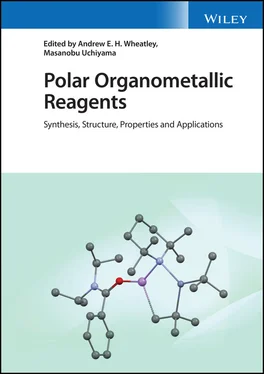Polar Organometallic Reagents
Здесь есть возможность читать онлайн «Polar Organometallic Reagents» — ознакомительный отрывок электронной книги совершенно бесплатно, а после прочтения отрывка купить полную версию. В некоторых случаях можно слушать аудио, скачать через торрент в формате fb2 и присутствует краткое содержание. Жанр: unrecognised, на английском языке. Описание произведения, (предисловие) а так же отзывы посетителей доступны на портале библиотеки ЛибКат.
- Название:Polar Organometallic Reagents
- Автор:
- Жанр:
- Год:неизвестен
- ISBN:нет данных
- Рейтинг книги:5 / 5. Голосов: 1
-
Избранное:Добавить в избранное
- Отзывы:
-
Ваша оценка:
- 100
- 1
- 2
- 3
- 4
- 5
Polar Organometallic Reagents: краткое содержание, описание и аннотация
Предлагаем к чтению аннотацию, описание, краткое содержание или предисловие (зависит от того, что написал сам автор книги «Polar Organometallic Reagents»). Если вы не нашли необходимую информацию о книге — напишите в комментариях, мы постараемся отыскать её.
Polar Organometallic Reagents
Polar Organometallic Reagents
Polar Organometallic Reagents — читать онлайн ознакомительный отрывок
Ниже представлен текст книги, разбитый по страницам. Система сохранения места последней прочитанной страницы, позволяет с удобством читать онлайн бесплатно книгу «Polar Organometallic Reagents», без необходимости каждый раз заново искать на чём Вы остановились. Поставьте закладку, и сможете в любой момент перейти на страницу, на которой закончили чтение.
Интервал:
Закладка:
4 Chapter 4Figure 4.1 Dimeric, tethered, and di‐nucleating types of heterobimetallic ca...Scheme 4.1 Synthesis of RuZn complexes ( 2– 4). Counter‐ions omitted for clari...Figure 4.2 Computed reaction profile for the formation of 2, 3, and 4. Schem...Scheme 4.2 Synthesis of Ru–In and Ru–Ga complexes ( 5– 8).Figure 4.3 Ru–In adduct intermediate to formation of 5, showing sources of e...Scheme 4.3 Synthesis of Ru–M complexes ( 9– 12) (M = Li, Mg, Zn) and subsequen...Figure 4.4 (a) Molecular structure of 12. Ellipsoids are represented at 30% ...Figure 4.5 Computed energy profile for Zn‐assisted and Zn‐free C–H reductive...Figure 4.6 Electronic structure analysis of 12′and its Mg cogener 12′...Scheme 4.4 Bimetallic complexes for catalytic hydrogenation of alkynes.Figure 4.7 Selected Wiberg bond index values for the reaction between 13´...Figure 4.8 Selected natural charge values derived from natural population an...Figure 4.9 General structure of bimetallic complexes prepared by Lu et al.Figure 4.10 Selected natural orbitals obtained from a CASSCF calculation of ...Figure 4.11 Possible pathways investigated computationally for the hydrogena...Figure 4.12 Relative free energies of the transition state for and product o...Scheme 4.5 Activation of nitrogen by FeAl −complex, and formal 4‐elect...Figure 4.13 Qualitative diagram showing MO occupation for the [CoM′‐N 2] − se...Scheme 4.6 Silylation of nitrogen catalysed by CoCo complex.Figure 4.14 (a) DFT‐calculated mechanism for the CoCo‐mediated silylation of...Figure 4.15 Energy difference between open and closed forms of complex 14de...Scheme 4.7 Pd–M complexes (M = Al, Ga, In), and catalytic hydrosilylation of...Scheme 4.8 Pd–M complexes (M = Li, Cu, Zn) and catalytic hydrosilylation of ...Figure 4.16 Effect of changing supporting metal on a range of calculated par...Figure 4.17 Simplified mechanism for the coordination insertion polymerizati...Figure 4.18 Selected metallocene‐based heterobimetallic catalysts for olefin...Figure 4.19 Structures of (half)‐metallocene‐based catalysts 19–22.Figure 4.20 Solid‐state molecular structure of 21, obtained by X‐ray diffrac...Figure 4.21 Free energies and DFT‐optimized structures of (η 5‐2,5‐Me 2C 4H 2NAl...Figure 4.22 Solid‐state molecular structure of 23, obtained by X‐ray diffrac...Figure 4.23 Proposed mechanism, based on experimental and computational work...Scheme 4.9 Synthesis of the Ti/Zr heterobimetallic catalyst 24.Figure 4.24 Proposed scenario for enhanced polyolefin chain branching mediat...Scheme 4.10 Synthesis of the heterobimetallic catalysts 25–27.Figure 4.25 Branches/1000 C in the polyethylene produced by the mixture of m...Figure 4.26 Energetic profiles (kcal/mol) for propagation (blue) and termina...Figure 4.27 Proposed mechanism for 1‐hexene generation and subsequent copoly...Figure 4.28 Solid‐state molecular structure of 28obtained by X‐ray diffract...Figure 4.29 Solid‐state molecular structure of 29obtained by X‐ray diffract...Scheme 4.11 Metalation of mononuclear complex (NON)Ni(C 4H 7) by ZnBr 2, to giv...Figure 4.30 Influence of coordination pattern in the activity of heterobimet...Figure 4.31 X‐ray crystal structure of 31([NiNa(Ph)(PPh 3)(L3)][BAr F 4]). L3...Figure 4.32 Structure–activity correlation plot showing the effect of differ...Figure 4.33 Solid‐state molecular structure of 32obtained by X‐ray diffract...Figure 4.34 Metal‐catalyzed coordination–insertion mechanism for the ROP of ...Figure 4.35 Bifunctional mechanism for the ROP of lactide (A: Lewis acid; B:...Figure 4.36 Concept of a bifunctional mechanism for the ROP of lactide invol...Figure 4.37 Selected structures of ‘M 1–O–M 2’ heterobimetallic catalysts for ...Figure 4.38 Solid‐state molecular structure of 39obtained by X‐ray diffract...Figure 4.39 Solid‐state molecular structure of 40obtained by X‐ray diffract...Scheme 4.12 Synthesis of Ti monometallic and Ti/Zn heterobimetallic complexe...Figure 4.40 Solid‐state molecular structure of 41obtained by X‐ray diffract...Scheme 4.13 Synthesis of Al/Zn heterobimetallic complex 42.Figure 4.41 Solid‐state molecular structure of 43obtained by X‐ray diffract...Scheme 4.14 Synthesis of Ge/Li and Sn/Li heterobimetallic complexes 44and 4...Figure 4.42 Structure of Cr/Al complex 46and heterobimetallic catalysis str...Figure 4.43 Catalytic cycle for the CO 2/epoxide copolymerization, including ...Figure 4.44 Computed potential energy surface of the first propagation cycle...Figure 4.45 Illustration (not to scale) of the potential energy surface for ...Figure 4.46 Chain shuttling mechanism.Figure 4.47 Solid‐state molecular structure of 47obtained by X‐ray diffract...Scheme 4.15 Synthesis of RE/zinc heterometallic complexes by ligand redistri...Figure 4.48 Solid‐state molecular structure of La/Zn complex 48obtained by ...Figure 4.49 Solid‐state molecular structure of Co/La complex 49obtained by ...Scheme 4.16 Synthesis of heterobimetallic Zn/Mg complex 50.Figure 4.50 Heterobimetallic complexes supported by a macrocyclic diphenolat...Figure 4.51 Solid‐state molecular structure of Zn/In complex 51obtained by ...Figure 4.52 ΔH ‡(solid squares, with errors ±1.3) and |ΔS‡| (open circ...
5 Chapter 5Figure 5.1 Mononuclear borocations classified on the basis of coordination n...Figure 5.2 Summary of a few common synthetic strategies employed for cationi...Figure 5.3 Popular experimental and computational methods for the determinat...Scheme 5.1 Isodesmic reactions to calculate chloride, fluoride, and hydride ...Scheme 5.2 Two coordinate C‐bonded Mes 2B +borinium cation and its reaction w...Scheme 5.3 Reactivity behaviour of Mes 2B +borinium cation; with H 2and HSiEtScheme 5.4 Reactivity of [( i ‐Pr 2N) 2B][B(C 6F 5) 4] with unsaturated molecules....Scheme 5.5 Adduct formation between borocation 13and Et 3PO demonstrating th...Figure 5.4 Initial examples of NHC‐stabilized aryl‐ and alkyl‐borenium catio...Scheme 5.6 Synthesis of NHC‐stabilized borenium cations (top) and reactivity...Scheme 5.7 Generation of NHC‐stabilized iminioborenium cation via silylation...Scheme 5.8 Dehydrogenative cationic borylation of NHC‐BH 3adduct and generat...Figure 5.5 NHC‐ and CAAC‐stabilized dibenzo[b,f]borepinium ( n = 2) and 9‐bor...Scheme 5.9 General scheme for the synthesis of air stable π‐conjugated benzo...Figure 5.6 Structure of polycyclic diborenium ion 32[NTf 2] 2and its solid‐st...Figure 5.7 NHSi–borenium cation and canonical structures of silylene support...Scheme 5.10 Ylide‐stabilized borenium cation.Figure 5.8 Structure of phosphine‐stabilized borenium cation 36, the counter...Scheme 5.11 Phosphine‐stabilized borenium cation and its reactivity with amm...Figure 5.9 Structurally characterized bis(phosphinimino)amide‐stabilized bor...Scheme 5.12 Synthesis of bis(phosphinimino)amide supported borenium cations....Scheme 5.13 A series of borocations stabilized by tunable diazadienes.Figure 5.10 Single‐crystal X‐ray structure of (a) [BrHB(dcpe)]Br, (b) [H 2B(t...Figure 5.11 Examples of boronium cations.Figure 5.12 Bisphosphine‐stabilized boronium cation 52[BF 4] and its phosphon...Scheme 5.14 Amidinato silylene‐stabilized borenium cations.Figure 5.13 Examples of a few selected organoaluminium cations.Scheme 5.15 A few common synthetic methods to generate cationic aluminium sp...Scheme 5.16 Two coordinated organoaluminium and gallium cations.Figure 5.14 Molecular structures of (car)borane‐complexed aluminium cations ...Scheme 5.17 Tetracoordinated aluminium cations and reactivity with Lewis bas...Figure 5.15 Zwitterionic “Meisenheimer type” pentacoordinated aluminium comp...Scheme 5.18 THF adduct of bis(allyl)‐substituted aluminium cations.Scheme 5.19 NHC‐stabilized dimeric aluminium dication 67and monomeric alumi...Scheme 5.20 Cationic aluminium hydride complexes stabilized by NHC via norma...Scheme 5.21 Selected example of NHC coordinated alkyl aluminium cations.Scheme 5.22 Cationic alkylaluminium complexes stabilized by redox active non...Figure 5.16 Examples of aluminium cations supported by N , N' ‐chelating li...Figure 5.17 Molecular structure of organoaluminium cation 86[MeB(C 6F 5) 3]....Scheme 5.23 Synthesis of a π‐electron‐donating ligand‐stabilized cationic al...Figure 5.18 Examples of a few selected miscellaneous aluminium cations.Figure 5.19 A few selected structurally characterized gallium and indium cat...Scheme 5.24 Nitrile adduct of NHC‐stabilized gallium chloride cations.Scheme 5.25 An NHC‐stabilized cationic indium complex.Figure 5.20 [ N , N' , O ]‐coordinated indium cations.Scheme 5.26 Cationic indium complexes supported by salen ligand.Figure 5.21 Structure of the cation in [Ga(PPh 3) 3] +[Al{OC(CF 3) 3} 4] −·1....Figure 5.22 Examples of indium(I) cations.Figure 5.23 Examples of Tl(I) cations.Scheme 5.27 Generalized scheme for hydroboration reaction with active borane...Figure 5.24 Reaction pathway for hydroboration of alkyne.Scheme 5.28 Hydroboration of pyridines catalyzed by NH 4BPh 4.Figure 5.25 Proposed reaction pathway for regioselective 1,4‐hydroboration o...Scheme 5.29 Hydrosilylation and deoxygenation of ketones catalyzed by 13[B(CScheme 5.30 Hydrosilylation of carbonyl with HSiEt 3catalyzed by borenium ca...Figure 5.26 Proposed catalytic cycle for hydrosilylation of benzaldehyde cat...Scheme 5.31 Borenium cation mediated activation of H 2in the presence of ext...Figure 5.27 Proposed hydrogenation pathway for carbene‐stabilized borenium i...Scheme 5.32 Assorted mesoionic carbene‐stabilized borenium cations as cataly...Figure 5.28 Chiral carbenes ( 112and 113), borenium cations ( 115–116),...Figure 5.29 Chiral borane adducts as precursors for borenium catalysts for h...Scheme 5.33 Aluminium cation‐catalyzed hydroboration of carbonyls.Scheme 5.34 Proposed mechanism for cationic aluminium species‐catalyzed hydr...Scheme 5.35 Selective hydroboration of ketones catalyzed by complex 65a.Scheme 5.36 Selective hydroboration of alkynes catalyzed by complex 65a.Scheme 5.37 Pentacoordinated aluminium cation‐catalyzed cyanosilylation of c...Scheme 5.38 Organoaluminium cation‐catalyzed cyanosilylation of carbonyls.Scheme 5.39 Hydrosilylation of carbonyls and imines catalyzed by complex 95[...Scheme 5.40 Hydrosilylation of alkenes and alkynes catalyzed by aluminium hy...Figure 5.30 Plausible mechanisms for the hydrosilylation of alkene catalyzed...Scheme 5.41 Hydrosilylation of ketones catalyzed by a cationic aluminium com...Figure 5.31 Proposed mechanism for the Tischenko reaction catalyzed by an al...Scheme 5.42 Hydroamination of (top) primary and (bottom) secondary amino alk...Figure 5.32 Coordination–insertion mechanism proposed for the ROP of ε‐capro...Scheme 5.43 C–C bond formation through activation of alcohols by cationic ga...Scheme 5.44 Olefin epoxidation catalyzed by cationic gallium and aluminium c...Scheme 5.45 Catalytic transfer hydrogenation of alkenes.Scheme 5.46 Hydroarylation reactions catalyzed by cationic gallium and indiu...Scheme 5.47 Trimolecular hydroarylation of alkynes catalyzed by a Ga(I) comp...Figure 5.33 Cationic gallium‐catalyzed hydroarylation of alkynes followed by...Scheme 5.48 Cycloisomerization of enyne.Scheme 5.49 Tandem carbonyl‐olefin metathesis catalyzed by a cationic galliu...Scheme 5.50 Synthesis of spiro‐ ortho esters (SOEs).Scheme 5.51 ROP of epoxide catalyzed by a cationic indium complex.Scheme 5.52 A variety of cationic indium complexes utilized for the ROP of a...Figure 5.34 Cationic indium complexes for polymerization of lactide/ε‐caprol...
Читать дальшеИнтервал:
Закладка:
Похожие книги на «Polar Organometallic Reagents»
Представляем Вашему вниманию похожие книги на «Polar Organometallic Reagents» списком для выбора. Мы отобрали схожую по названию и смыслу литературу в надежде предоставить читателям больше вариантов отыскать новые, интересные, ещё непрочитанные произведения.
Обсуждение, отзывы о книге «Polar Organometallic Reagents» и просто собственные мнения читателей. Оставьте ваши комментарии, напишите, что Вы думаете о произведении, его смысле или главных героях. Укажите что конкретно понравилось, а что нет, и почему Вы так считаете.












